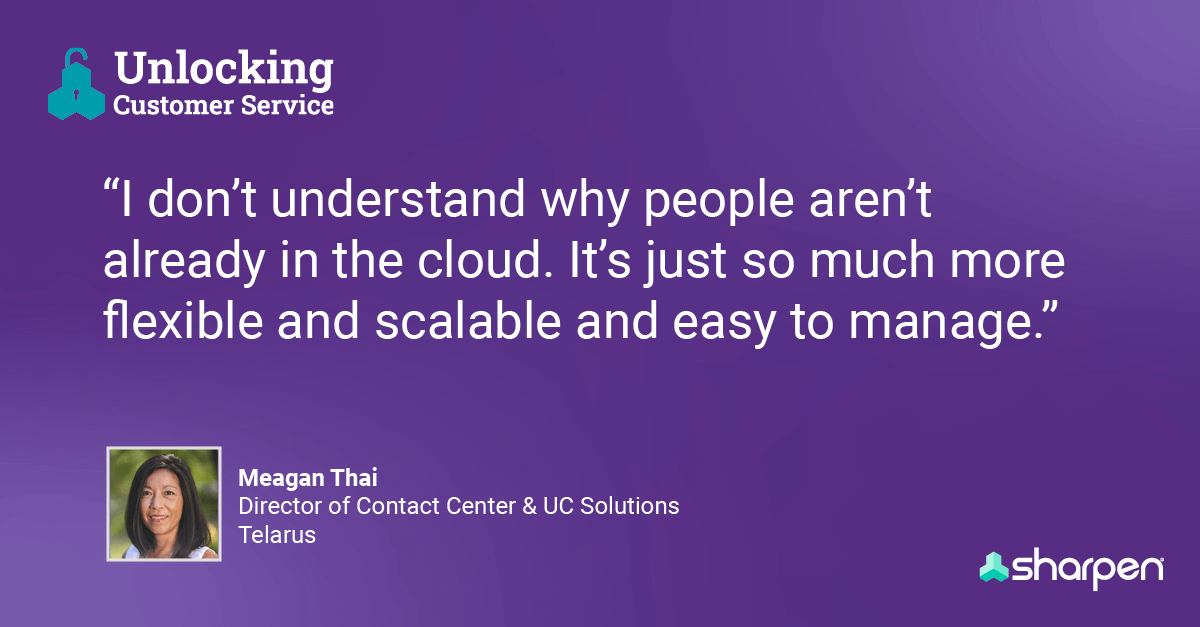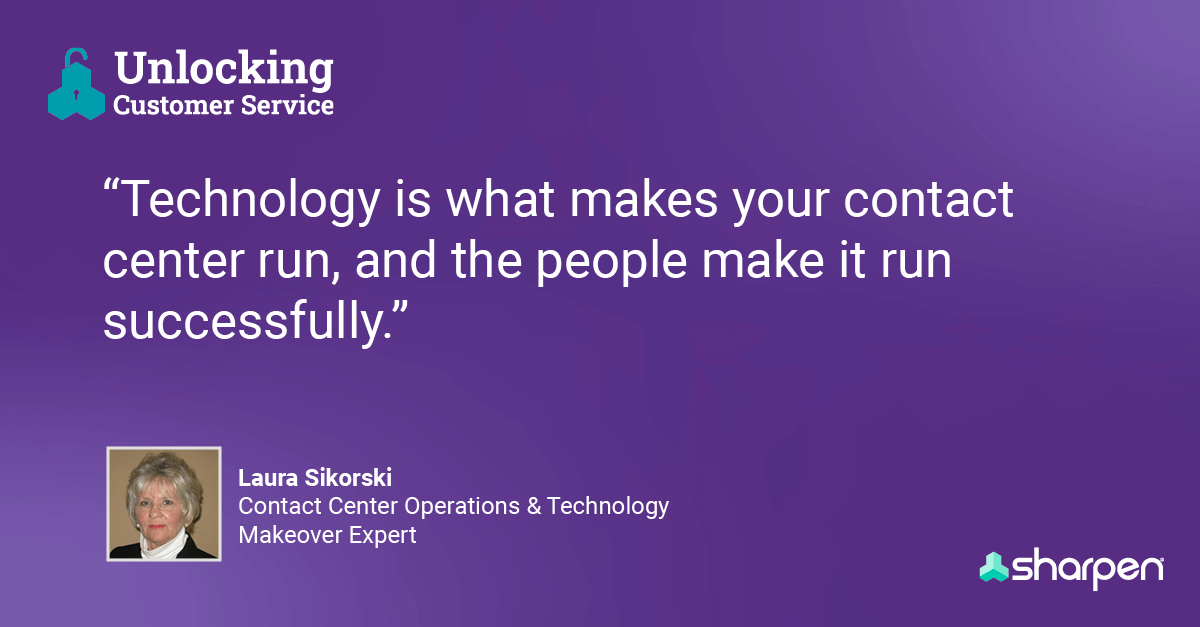
Digital Transformation in the Contact Center: Cloud Migration Lessons from the Trenches
Contact centers have a mounting list of priorities and criteria to make the customer experience a success. But running a successful operation hinges on your technology and what it allows your team of agents and leaders to do. And right now, outdated technology is holding CSAT scores in a guillotine choke.
Companies are looking for ways to push past the bounds of current CX standards and transform the way they do business, but decades-old contact center platforms hold them back.
>> Download Now: Get Frost & Sullivan’s Buyers Guide to inform your buying decisions
To transform your customer experience and leave the CX stragglers behind, you need flexibility, simplicity, and tools with a lower financial burden. That’s where a cloud contact center solution (like Sharpen’s) comes in.
To understand digital transformation, we put two industry titans on a call. Then we siphoned out every ounce of knowledge we could and put it into a 30-minute presentation. Sheila McGee-Smith, President and Principal Analyst at McGee-Smith Analytics and Pam Hynes, COO of Sharpen, talked through what it takes to move your contact center to the cloud.
Pam and Sheila pooled their decades of industry experience and shelled out actionable tactics to help you pilot modern-day cloud migration.
Here’s what the two titans said about moving to a cloud contact center solution and all the benefits a modern-day migration can bring to your business.
>> Watch now: Jump straight to the on-demand webinar
How modern cloud migration looks different from early migration
Early cloud migration teased the benefits of the cloud, but companies couldn’t get the full value of a platform built with inherent flexibility. Today, cloud-native platforms offer up more value, at scale. As you type a few keywords in the Google search bar and kick off your hunt for a contact center partner, know what to look for. It’s crucial to go into your search with 20/20 vision to spot the differences in all the cloud tech that’s out there.
“This notion of being in the cloud, it’s something that companies looking to move from premises have to look at. Where on the cloud journey is the vendor that they’re speaking to? How do you differentiate one cloud vendor from another? Because everybody is using that terminology, but they’re using it very differently.”
– Sheila McGee-Smith
Early migration
Pam’s life in the contact center industry placed her in the throes of early cloud migration more than a decade ago. In those early days, on-premises vendors started looking for ways to hitch their kite onto the cloud movement. The solution then was to offer up single-tenant, hosted cloud tech as an aside with their on-prem software.
As an early solution, hosted tech gave a glimpse into the practicality of the cloud. But it still had a few kinks to work out. For instance, Sheila said, there’s a massive gap in a company’s elasticity. With hosted solutions, it’s still a very manual (and painful) experience to scale up or down as your business needs change. Forget about making changes in a pinch during your peak season, too.

Companies need systems that can bend when they bend, but a single-tenant, hosted solution doesn’t have that kind of flexibility. You end up stuck with painful upgrades when vendors release new features and security updates, interrupting your service and impacting your uptime. Not to mention, it becomes much harder to keep up with the always-changing security landscape when it takes longer to push important releases.
>> Learn More: Sharpen’s call center platform is built with security in mind
Present migration
Modern cloud technology makes scaling ultra-efficient. At Sharpen, Pam heads up our operations and helps contact centers migrate to the cloud. And while she held this type of role in the early days of cloud tech, this time, she’s setting users up with a cloud-native platform. The scalability that comes with today’s cloud solutions lets you flex demand based on your business needs, without thinking about hardware or unruly maintenance.
And with a company’s ability to scale comes a vendor’s ability to iterate and enhance your end-user experience. Modern cloud architecture lets folks like us make changes (big or small) to products without disrupting our clients and your customer service.
In today’s corporate landscape, Pam said, it’s crucial to think about how the team you partner with updates and changes their product. And, you have to think about how those changes will impact your goals and your customer journey, too.
Your partner vendor should empower you to use features or change configurations at your discretion when it makes sense for your customer journey.
Thinking back to another webinar with HotSchedules, one of Sharpen’s oldest customers, we learned the importance of a flexible platform. Making fast changes was high on the contact center’s priority list when leaders vetted new tech. Ray Gallagher, their former VP of Customer Care, needed his contact center leaders to have the autonomy to make changes to their platform without tagging in IT.
As Sheila put it, “to IT, you’re one of the many parts of the business that require attention. So, your request, while crazy important to you, is just one of the many things the IT department has to do.” She continued, “So, the ability to make your own changes is such a big part of the modern cloud environment. And it’s really something that isn’t possible with single-tenant cloud solutions.”
In the past, with single-tenant solutions, companies didn’t have the flexibility to make changes to systems on their own. A task as simple (albeit important) as changing an IVR route required companies to go through their IT team or vendor, waiting weeks for a fix that should’ve been easy.
The criteria that matter when companies choose a cloud contact center solution
Pam and Sheila listed off the reasons they hear over (and over) when decision makers share why they move to modern cloud platforms.
- Security and compliance. Today’s fast-paced security and compliance landscape requires you to make speedy changes to customer platforms to keep their information safe. Hosted or on-prem solutions take too long (and are too painful) to update. Cloud-native platforms let your vendor tackle security updates efficiently and effectively.
- The ability to scale efficiently. Companies don’t have to worry about changing their entire infrastructure or missing important timelines. Again, the elasticity of cloud platforms lets businesses adapt and change whenever they need to.
- Easier implementation and updates. Nobody wants a solution that’s going to disrupt their customer journey. (It wouldn’t really be a solution, then, would it?) Cloud platforms cut down on implementation timelines and push updates without downtime or frustrating experiences.
- The cost of ownership. A cloud contact center solution puts money back in your company bank account. Modern cloud tools are easier to maintain, manage, and update. Plus, when you add in the opportunity cost of a better customer (and agent!) experience, cloud solutions deliver irrefutable ROI. (Aheeeem…. Calculate the potential savings for yourself.)
- Vendors invest in the cloud. Even vendors with thousands of customers using their on-premises solutions are betting on the cloud. The cloud is where vendors invest time, spend, and innovation to improve offerings for their customers.
How do you ensure a successful migration?
First and foremost, you need a project plan that both you and your vendor partner can stick to.
From a customer’s perspective, it’s mission-critical to explain your business needs and the needs of your team to your vendor partner. The right partner tailors your implementation and experience to your specific business case, so you can reach your customer and revenue goals. From the perspective of your potential partner (like us) it’s really important that vendors understand the goals and expected outcomes of our customers.
At Sharpen, we recommend every contact center include an agent in the project planning process. Your agents are the end-users of your contact center platform. They’re the ones who need to understand and champion your technology changes. Listen to them.

Lastly, step back and identify what you need to make your customer journey successful. Don’t overthink it and jump ahead of yourself with shiny, new features clouding your brain. Document the key improvements you need to make with your initial transition. Then, create a roadmap for how you’ll continue to improve. Don’t try to introduce too much, too fast.
Moving to the cloud is a big change in and of itself. Start there.
Key takeaway
“Life is better in the cloud.” – Sheila McGee-Smith
We originally published this post on May 29, 2019, and we updated it for new insight on September 23, 2021.

